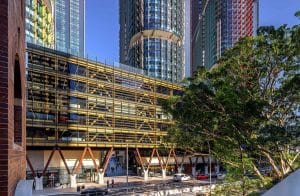LEED is one of the most popular green building certification programs worldwide designed by the U.S. Green Building Council. It provides third-party verification that a particular building or complex was designed and constructed keeping in mind the following parameters:
- Maximum energy savings
- Efficient use of water
- Reduced greenhouse gas emissions
- Healthier indoor air quality
- Increased use of recycled materials
- Optimum utilization of resources and sensitivity to their impacts
- Reduced maintenance and operation costs
The popularity of LEED certified buildings is on the rise around the world because it means that we now have a healthier, more productive space for living and working, while placing minimum stress on the environment.
Buildings that earn LEED certification offer a multitude of benefits. These range from water and energy savings to improved human health and waste reduction. Further, LEED certified buildings command higher tenant rates and have higher resale value too.
Please note that there are four different levels of LEED certification – Platinum, Gold, Silver and Certified.
What are LEED schools?
In simple terms, an educational facility that has earned a LEED certification is a LEED school.
With today’s greater emphasis on sustainability, energy efficiency and healthy environments for students, educational facilities can benefit from seeking Leadership in Energy and Environmental Design (LEED) certification.
The LEED standard is designed to encourage the construction of environmentally healthy and energy-efficient facilities. Incorporating the LEED guidelines and best practices related to indoor air quality can especially benefit students because U.S. Environmental Protection Agency reports that poor indoor air quality causes student illnesses and increases absenteeism.
An important component of the LEED certification is the section designed to reduce volatile organic compound (VOC) emissions indoors. These emissions can damage air quality and human health, according to the U.S. Green Building Council (USGBC).
In the first half of 2019, more than 100 schools received LEED certification in the US, which is a pretty impressive number. With 2019’s LEED certifications, nearly 64,000 students are now learning in spaces that have a reduced impact on local resources and an enhanced impact on occupant health and productivity. These students will learn early lessons about sustainable living that will influence decisions throughout their lives.
Further Reading:
- Getting Started with LEED v4 Certification and LEED v4 Accreditation
- 10 Reasons to Become LEED Accredited
- Green Building Certification Programs 2020
- Is LEED Certification Important for Civil Engineers?
- LEED Professional Exams
Benefits of Green Schools
School facilities have a direct impact on student learning, student and staff health, and school finances. Well-designed school facilities are proven to have dramatic effects on measurable academic outcomes as well as health of the faculty and students alike. Listed below are some of the many benefits offered by green schools:
Improved Indoor Air Quality
More than 20 percent of public schools in the US are reported to have unsatisfactory indoor air quality, according to the Department of Education. Carnegie Mellon University has shown in studies that there is an average overall health improvement rate of 41% when the indoor air quality is improved. This is why green schools focus on taking appropriate measures to improve their indoor air quality.
Increase Student Performance
A lack of fresh air can reduce student attentiveness. Studies have shown that student test scores can improve up to 20% when kids learn in green classrooms that have more daylighting, improved classroom acoustics, and healthier paints and carpets that don’t release toxic chemicals into the air. Also, green schools typically show greater student engagement, reduced disciplinary issues, and increased performance on standardized tests.
Less Absenteeism
Asthma is the leading cause of disease-related absenteeism in U.S. public schools. By improving indoor air quality, green schools can improve the health of students, faculty and staff, potentially decreasing sick days. With public schools relying on average daily attendance rates to receive federal funding, improved attendance is of particular importance. Also, when toxic chemicals — often found in paint, flooring and furniture as well as conventional cleaning, pest management and snow removal products — are eliminated, students and staff report less eye, nose and throat irritation, and asthma-related incidents decline.
Reduced Carbon Emissions
Green schools significantly reduce carbon dioxide emissions. Building 34 new green schools in Los Angeles alone would reduce 94,000 tons of CO2 — the equivalent of eliminating more than 15,000 cars from the road every year, or planting more than 280,000 trees.
Better Teacher Retention
A green school can reduce teacher turnover by as much as 5%, which improves student learning and school community, and can result in financial savings for the school.
Less Operating Costs and Water usage
Operating costs for energy and water in a green school can be reduced by 20% to 40%, directing more funding towards teacher salaries, textbooks, and computers. Also, on an average, a green school reduces water usage by 32%. This reduction has direct savings for the building, as well as substantial societal benefits, such as reducing storm-water runoff, and transporting and treating wastewater.
Provide an Educational Opportunity for Children
Green schools adopt a lot of sustainable practices that provide a learning opportunity for kids and make them aware of how to care for their environment and live sustainably.
How to get a school LEED certified?
Obtaining LEED certification provides third-party verification that the building or district is performing in a sustainable manner on a continuous basis. Educational institutions have the following two options when it comes to LEED certification:
LEED for Building Design and Construction: Schools construction or renovation of buildings dedicated to K-12 learning
LEED for Operations and Maintenance: Schools day-to-day operation of existing buildings dedicated to K-12 learning
Also Read:
The Center for Green Schools at USGBC exists to assist schools and school districts who want to help students succeed while supporting student health and the health of the planet. Several resources are available on centerforgreenschools.org for those looking to build or renovate a school:
The Paid from Savings Guide to Green Existing Buildings: Reviews strategies and case studies to help leverage utility cost savings to fund comprehensive green building retrofits.
Green Schools Investment Guide: Details financing strategies for building projects, from small-scale improvements to major renovations, to help schools choose the right path for them.
Powering Down Guide: Profiles schools that achieved 20-37% energy reduction through behavior strategies alone.
State of Our Schools: America’s K-12 Facilities: Compiles and analyzes the best available school district data about US K-12 public school facilities funding.
The Impact of School Buildings on Student Health and Performance: A review of current research connecting school buildings with student health and performance.
Is building a green school costlier than building a conventional one?
On average, green schools use 33 percent less energy and 32 percent less water than their conventional counterparts, and save $100,000 per year on direct operating costs. More than 3,000 schools are LEED certified. Many of these schools, particularly those built in the last three years indicate that they have achieved LEED certification for no additional cost to the project’s budget and oftentimes for a total cost that is less than regional construction costs for conventional schools built during the same time period.
Projects across the US have earned certification without any cost premium while saving taxpayer money. Listed below are a few examples:
Wisconsin’s LEED Platinum Lake Mills Middle School is 45 percent more efficient than a conventional school, yielding a total annual energy savings of $85,000, returning nearly $700,000 back to taxpayers thus far.
Ohio’s investment in green schools is already paying off but there is more to come. The Ohio Facilities Construction Commission has projected that its energy savings will double the initial expenditure on its more than 300 LEED certified schools in approximately 10 years.
Fossil Ridge High School in Colorado earned LEED certification without incurring additional costs. At $179 per square foot, including design fees, furnishings and equipment, Fossil Ridge’s cost compares favorably with other school building projects in the region. And that doesn’t include the significant long-term savings from reduced water and energy use over the lifetime of the school.
West Brazos Junior High in Texas achieved LEED certification for a total project cost that was 18% less than other schools built in the region that year, and found that its maintenance, operations and utilities costs are lower compared to traditional facilities.
With inputs from:
https://bostongreenschools.org/what-is-a-green-school/
https://www.usgbc.org/articles/green-school-facts
https://www.centerforgreenschools.org/sites/default/files/resource-files/schools-info-sheet.pdf











